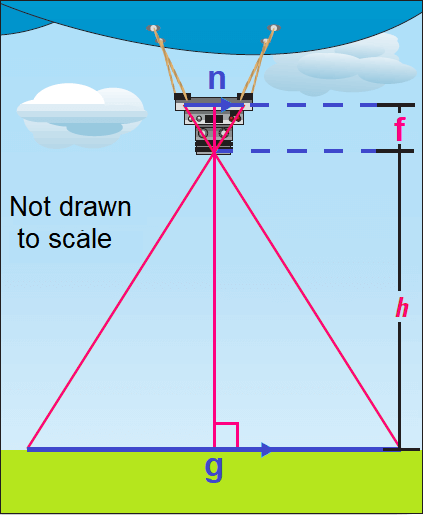WORKSHEET ON SIMILAR TRIANGLES
Problem 1 :
In the diagram shown below ΔACB ∼ ΔDCE.
a. Write the statement of proportionality.
b. Find ∠CDE.
c. Find DC and AD.

Problem 2 :
Color variations in the tourmaline crystal shown below lie along the sides of isosceles triangles. In the triangles each vertex angle measures 52°. Explain why the triangles are similar.

Problem 3 :
Use properties of similar triangles to explain why any two points on a line can be used to calculate the slope. Find the slope of the line using both pairs of points shown.

Problem 4 :
Low-level aerial photos can be taken using a remote-controlled camera suspended from a blimp. we want to take an aerial photo that covers a ground distance g of 50 meters. Use the proportion f/h = n/g to estimate the altitude h that the blimp should fly at to take the photo. In the proportion, use f = 8 cm and n = 3 cm. These two variables are determined by the type of camera used.

Problem 5 :
Find the length of the altitude DG in the diagram shown below.


Answers
1. Answer :

Part (a) :
DC / AC = CE / CB = ED / BA
Part (b) :
Because ΔACB ∼ ΔDCE,
∠A ≅ ∠CDE
Then, we have
∠CDE = ∠A = 79°
Part (c) :
Write proportion.
ED / BA = DC / AC
Substitute.
3 / 12 = DC / 20
Multiply each side by 20.
20 ⋅ (3 / 12) = (DC / 20) ⋅ 20
Simplify.
5 = DC
Because AD = AC - DC,
AD = 20 - 5
AD = 15
So, DC is 5 units and AD is 15 units.
2. Answer :

Because the triangles are isosceles, we can determine that each base angle is 64°. Using the AA Similarity Postulate, we can conclude that the triangles are similar.
3. Answer :

By the AA Similarity Postulate ΔBEC ∼ ΔAFD, so the ratios of corresponding sides are the same.
In particular,
CE/DF = BE/AF
By a property of proportions, we have
CE/BE = DF/AF
The slope of a line is the ratio of the change in y to the corresponding change in x. The ratios CE/BE and DF/AF represent the slopes of BC and AD respectively.
Because the two slopes are equal, any two points on a line can be used to calculate its slope. We can verify this with specific values from the diagram.
Using slope formula,
Slope of BC = (3 - 0)/(4 - 2) = 3/2
Slope of AD = [6 - (-3)]/(4 - 2) = 9/6 = 3/2
4. Answer :

Write proportion.
f/h = n/g
Substitute.
8/h = 3/50
By reciprocal property of proportion,
h/8 = 50/3
Multiply each side by 8.
8 ⋅ (h/8) = 8 ⋅ (50/3)
Simplify.
h ≈ 133
So, the blimp should fly at an altitude of about 133 meters to take a photo that covers a ground distance of 50 meters.
5. Answer :

Find the scale factor of ΔADC to ΔFDE.
AC/FE = (12 + 12)/(8 + 8)
AC/FE = 24/16
AC/FE = 3/2
Now, because the ratio of the lengths of the altitudes is equal to the scale factor, we can write the following equation.
DB/DG = 3/2
Substitute 6 for DB and and solve for DG.
6/DG = 3/2
By reciprocal property of proportion,
DG/6 = 2/3
Multiply each side by 6.
6 ⋅ (DG/6) = (2/3) ⋅ 6
Simplify.
DG = 4
So, the length of the altitude DG is 4 units.
Kindly mail your feedback to v4formath@gmail.com
We always appreciate your feedback.
©All rights reserved. onlinemath4all.com
Recent Articles
-
Logarithmic Derivative Problems and Solutions
Apr 16, 25 09:25 PM
Logarithmic Derivative Problems and Solutions -
Digital SAT Math Problems and Solutions (Part - 145)
Apr 16, 25 12:35 PM
Digital SAT Math Problems and Solutions (Part - 145) -
Digital SAT Math Problems and Solutions (Part - 144)
Apr 14, 25 07:27 PM
Digital SAT Math Problems and Solutions (Part - 144)

